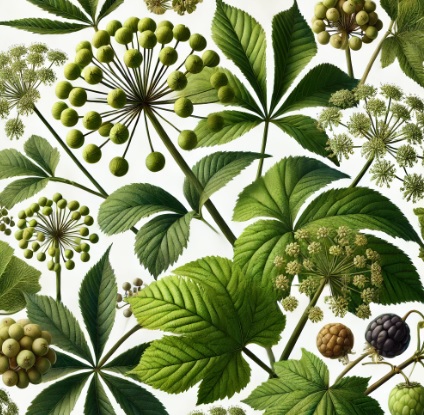The Araliaceae family is a group of plants in the order Apiales, comprising about 50 genera and over 400 species. It is primarily found in tropical and subtropical regions, with a few species in temperate zones. Plants in this family include trees, shrubs, and climbers, many of which are used for ornamental and medicinal purposes.
General Description
Plants in the Araliaceae family share several common characteristics:
- Leaves: The leaves are typically large, alternate, and often compound, with serrated or toothed margins. In some species, the leaves can be palmate, meaning the lobes radiate from a central point, such as in Panax (ginseng). The leaves are often glossy and can vary in size depending on the species.
- Flowers: The flowers are typically small, unisexual or hermaphroditic, and are grouped in inflorescences that form umbels or panicles. The flowers can be white, yellow, or green, depending on the species, and attract pollinators such as insects.
- Fruits: Fruits in the Araliaceae family are typically berries or drupes that contain one or more seeds. The fruit can be fleshy or dry, and in some species, it is rich in nutrients.
- Stems and Roots: The family includes both herbaceous and woody species, with plants growing as shrubs, trees, or climbers. The roots are often strong, and some species, like ginseng, have tuberous, long-lived roots.
Chemical Composition
The Araliaceae family is known for containing a variety of bioactive compounds, some of which are used in traditional medicine:
- Triterpenoid Saponins: Many plants in the Araliaceae family, such as Panax ginseng, contain triterpenoid saponins, known for their adaptogenic properties, which help the body manage stress and improve physical and mental endurance.
- Ginsenosides: Ginseng contains ginsenosides, a group of saponins that are associated with numerous health benefits, including increased energy, improved cognitive function, and immune system support.
- Polyphenols: Some species in the family, such as Aralia elata, contain polyphenols, which have antioxidant and anti-inflammatory properties.
- Phytosterols: Phytosterols found in some Araliaceae species can contribute to cardiovascular health by lowering cholesterol levels.
Physical Properties
Plants in the Araliaceae family are characterized by certain physical traits:
- Leaves: The leaves are typically large and compound, with serrated or toothed margins. Some species, like ginseng, have palmate leaves.
- Flowers: The flowers are generally small and grouped in umbels, a common characteristic of the family. The flowers often have free petals and are inconspicuous.
- Fruits: The fruits are usually berries or drupes, with a variable number of seeds inside. These fruits are often fleshy and nutrient-rich.
- Roots: Some species, such as ginseng, are known for their tuberous roots, which grow slowly and can be long-lived.
Production and Harvesting
Plants in the Araliaceae family are cultivated for various purposes, primarily medicinal and ornamental:
- Ginseng (Panax ginseng): Ginseng is cultivated for its roots, which are used in traditional medicine for their adaptogenic properties, improving endurance and reducing fatigue. The roots are harvested after 3-6 years of growth, depending on farming practices.
- Aralia (Aralia elata): Some species of Aralia are cultivated as ornamental plants, while others, like Aralia racemosa, are used for their medicinal properties.
- Climbing Plants: Some members of the family, such as Fatsia japonica, are grown as ornamental plants in gardens and landscapes for their attractive form and hardiness.
Applications
Medicinal
Plants in the Araliaceae family, particularly Panax ginseng, are used in traditional medicine for a variety of purposes:
- Ginseng (Panax ginseng): Ginseng is one of the most well-known adaptogens, used to increase energy, improve cognitive function, reduce stress, and support the immune system. It is commonly used in herbal preparations to treat fatigue, improve memory, and enhance physical endurance.
- Aralia (Aralia elata): The roots of some Aralia species are used in traditional medicine to treat respiratory disorders, such as coughs and lung infections, and to support immune function.
Cosmetics
The compounds found in plants of the Araliaceae family are also used in the cosmetics industry:
- Ginseng (Panax ginseng): Ginseng extracts are used in cosmetics and skincare products for their antioxidant, anti-inflammatory, and toning properties. Ginseng is often included in serums, creams, and lotions to improve skin elasticity and combat signs of aging.
- Aralia (Aralia elata): Extracts from Aralia are used for their moisturizing and nourishing properties, helping to keep the skin soft and smooth.
Environmental
The Araliaceae family also plays an important role in the environment:
- Biodiversity: Araliaceae plants provide habitat and nourishment for many species of insects, birds, and other animals.
- Ornamental: Species like Fatsia japonica are cultivated as ornamental plants for gardens and green spaces. Their large, glossy leaves make them attractive as indoor plants or for public space beautification.
Environmental and Safety Considerations
While plants in the Araliaceae family offer many benefits, there are some considerations:
- Sustainability: The harvesting of wild ginseng roots has been a concern for sustainability. It is important to harvest ginseng responsibly to prevent over-exploitation of wild populations.
- Toxicity: Some plants in the Araliaceae family, such as Aralia elata, may cause allergic reactions or irritations in sensitive individuals. It is always recommended to use these extracts under the supervision of an expert.
INCI Functions
- Antioxidant: Protects the skin from oxidative damage.
- Anti-inflammatory: Reduces inflammation and soothes irritated skin.
- Moisturizing: Helps hydrate and retain moisture in the skin.
- Toning: Helps improve skin tone and combat signs of aging.
Conclusion
The Araliaceae family is a significant group of plants that provide valuable resources in medicine, cosmetics, and the environment. Species like Panax ginseng are particularly well-known for their adaptogenic properties, while Aralia elata and Fatsia japonica are appreciated for their ornamental applications.
![]() Araliaceae
Araliaceae 

